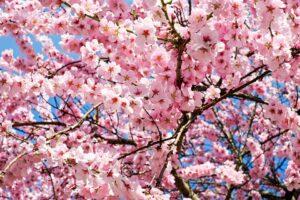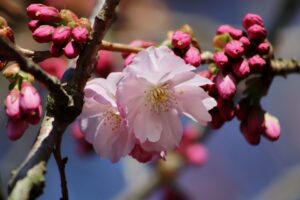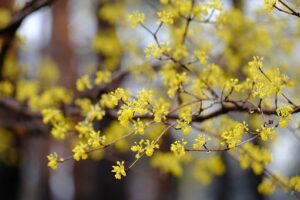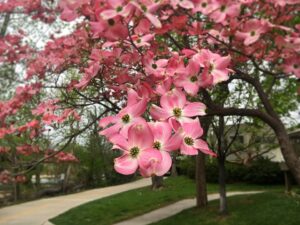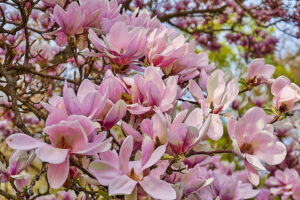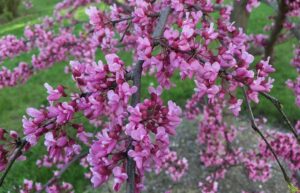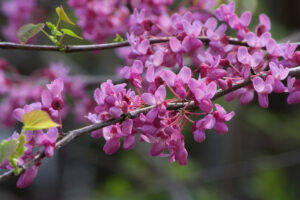It’s hard to imagine spring is right around the corner when temperatures are still so chilly! However, it will be here before we know it, so NOW is the time to select and plant spring flowering trees for your landscape.
To help you make the best choice for your yard, we’re sharing our Top 5 Spring Blooming Trees. These trees are stunners, thrive in the changing Pacific Northwest climate and are highly favored by landscape professionals.
Flowering trees contribute a wide range of benefits. Practically speaking, they are early-season pollinators and food sources for bees and insects, provide shade as spring turns to summer and even increase your home’s value. On the emotional side, these are the trees that stop us in our tracks! Their vibrant blooms, raise our spirits after the gray of winter as the flowers decorate branches with hues of white, yellow, purple, pink and red.
We hope our suggestions get your imagination going and help with your spring garden plans!
Here’s our Top 5!
1. Prunus serrulata ‘Kanzan’ (Kanzan Flowering Cherry)
- Kanzan Flowering Cherry Tree
- Flowering Cherry Blooms and Buds
DETAILS AND CARE INSTRUCTIONS
Rate of Growth: Moderate, reaching approximately 18-20’ tall, 12-20’ wide canopy per variety.
Growing Habit: Upright
Seasonal Interest: Scented flowers bloom in Spring. Flower petals are available in shades of pink and white.
Pretty bark adds year-round interest.
Exposure and Climate: Full sun, Zones 5-9
Water Needs: Always water until established. Refer to the nursery plant tag for specific care and/or
when the top 2 inches of soil are dry.
Uses: Japanese Flowering Cherry trees work well on their own or in a border along driveways, cottage
pathways, and in urban parks. Enjoy them while they are blooming and take lots of photos to share!
2. Cornus mas ‘Golden Glory’ (Golden Glory Cornelian Cherry)
- Cornellian Cherry
- Cornellian Cherry Berries
DETAILS AND CARE INSTRUCTIONS
Rate of Growth: Moderate, reaching 15’ tall, 15’ wide canopy.
Growing Habit: Multi-trunked and round or horizontal.
Seasonal Interest: Cornelian Cherry has yellow flowers that bloom in spring before the green foliage emerges. Ripe berries decorate the tree by the middle of summer.
The bark is layered and pretty in winter..
Sun Exposure and Climate: Part shade to part sun, Zones 4-8
Water Needs: Always water until established. Refer to the nursery plant tag for specific care and/or when the
top 2 inches of soil are dry.
Uses: Plant Cornelian Cherry as a privacy hedge and as a golden specimen tree.
3. Cornus florida ‘Cherokee sunset’ (Cherokee sunset Flowering Dogwood)
- Cherokee Sunset Dogwood Tree
- Cherokee Sunset Dogwood Bracts
DETAILS AND CARE INSTRUCTIONS
Rate of Growth: Moderate, reaching 18’ tall x 15’ wide canopy.
Growing Habit: Multi-trunked.
Seasonal Interest: Four uniquely curved petal-like bracts encircle a floret of tiny yellow flowers. Blooms in spring and summer.
Sun Exposure and Climate: Part sun- Full sun, Zones 4-8
Water Needs: Always water until established. Refer to the nursery plant tag for specific care and/or when the top 2 inches of soil are dry.
Uses: Flowering dogwoods are low maintenance and offer multiple seasons of interest. Plant the trees in front of evergreen hedges for added contrast and to provide
a sheltered place for birds to rest.
4. Magnolia x ‘Jane’ (Jane Magnolia)
- Jane Magnolia Blooms
- Jane Magnolia Tree
DETAILS AND CARE INSTRUCTIONS
Rate of Growth: Quickly reaching 20’-15’tall and wide canopy.
Growing Habit: Multi-trunked.
Seasonal Interest: Fragrant large flowers bloom in Spring. Shiny green leaves contrast with bowl shaped blooms.
Sun Exposure and Climate: Full sun, Zones 5-9
Water Needs: Always water until established. Refer to the nursery plant tag for specific care and/or water deeply once or twice a week during a drought.
Uses: Magnolia trees work well planted in a lawn area to add shade and within larger landscapes.
5. Cercis canadensis ‘Forest Pansy’ (Forest Pansy Redbud)
- Forest Pansy Tree
- Forest Pansy Blooms and Buds
DETAILS AND CARE INSTRUCTIONS
Rate of Growth: Moderate, reaching 20’ tall, 20’ wide canopy.
Growing Habit: Rounded Canopy
Seasonal Interest: Scented flowers bloom in early Spring. Buds turn into dark pink flowers and cover the branches of each tree. In Autumn, the maroon-colored heart-shaped leaves turn to a glowing yellow/orange color.
Sun Exposure and Climate: Full sun, Zones 5-9
Water Needs: Always water until established. Refer to the nursery plant tag for specific care and/or when the top 3 inches of soil are dry.
Uses: Eastern Redbud trees look beautiful when planted in a lawn area and as a focal point by a patio.
Keep enjoying “Top 5 Performing Plants for the Pacific Northwest” with Harmony Design Northwest by subscribing to our newsletter, and be on the lookout for our next post, “Top 5 Blooming Shrubs”.
Content contributor: EMILY PURDIN | stonybrooklandscapedesign.com
Credit to MONROVIA as a reference for plant sizes and care instructions. www.monrovia.com
Photo credit to PIXABAY and their wonderful contributors. www.pixabay.com


